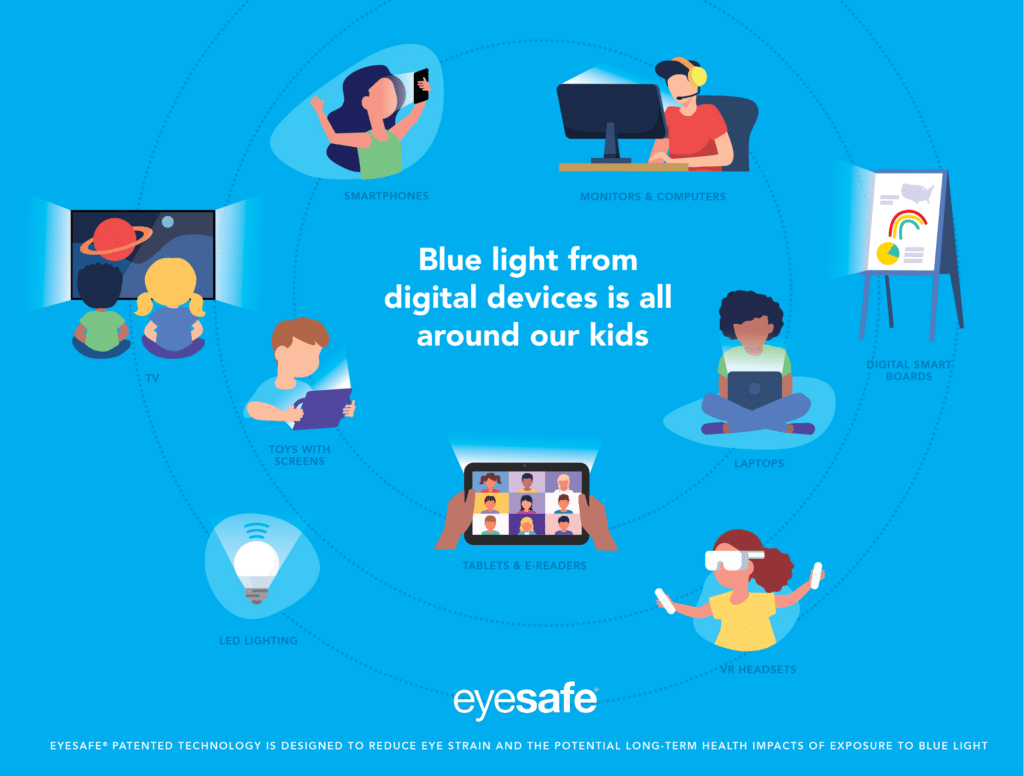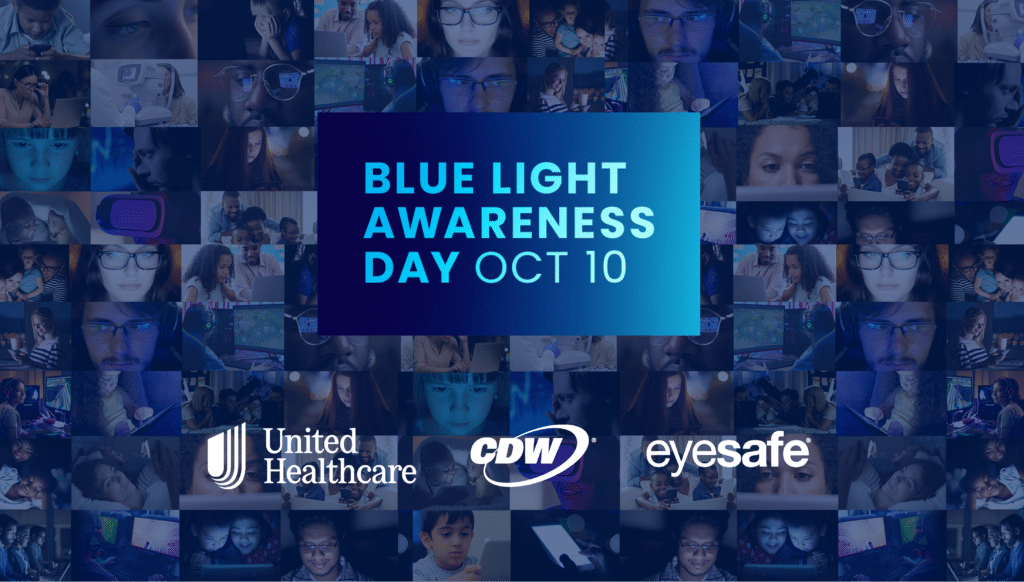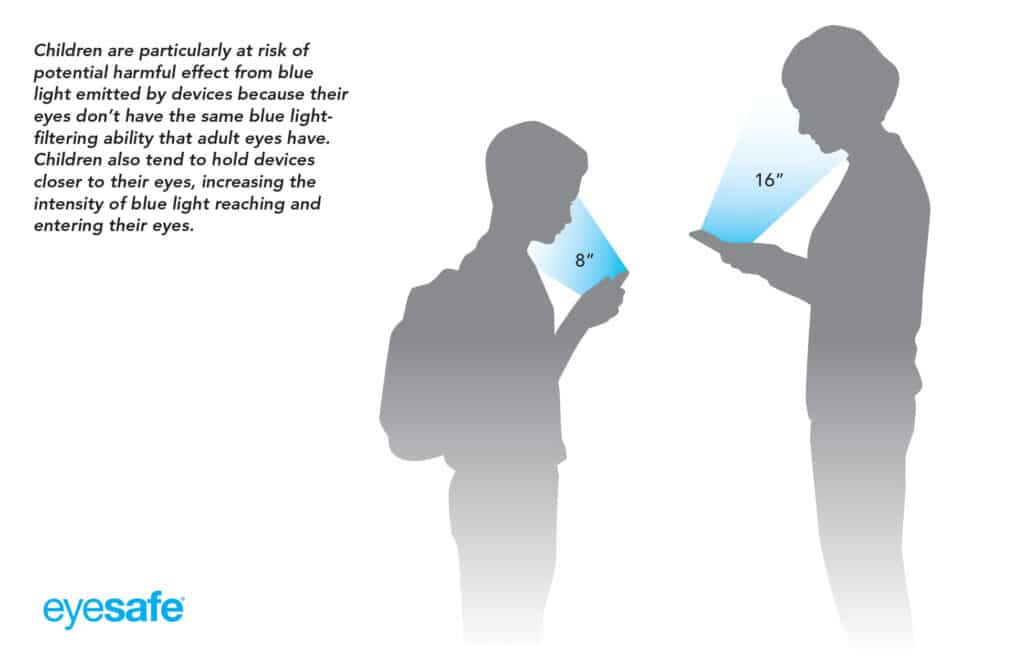The Importance of Student Eye Health on Blue Light Awareness Day
In our increasingly screen-centric world, technology has woven itself into our everyday lives, and education is no exception. From virtual assignments to online research and teacher-student communications, today’s generation of students rely heavily on digital devices for learning. While these tools offer countless advantages, they also come with a significant downside: blue light exposure. To raise awareness of the risks, UnitedHealthcare, CDW, and Eyesafe are hosting a nationwide K-12 webinar on Blue Light Awareness Day, observed every October 10th.
Understanding the Concern
Digital devices have become our primary tool for work, communication and entertainment. Classrooms and virtual learning environments have followed suit, incorporating laptops, tablets, and smartphones into daily routines. Programs such as 1:1, in which schools provide devices to every student, are increasing. Digital assessments and grading have gone online, while school districts are investing more in technology and IT infrastructure. These initiatives have contributed to higher screen time for kids.
Today, children ages 8-12 spend 4-6 hours per day using a digital device, while teens spend up to 9 hours.1 Doctors, parents and teachers have voiced concern about higher device use, and the potentially negative effects on children’s health.
The Science of Blue Light
Blue light, a component of the visible light spectrum, is characterized by its shorter wavelength and higher energy. It falls within the range of approximately 380 to 500 nanometers and is an integral part of the light emitted by the sun. It is also prevalent in artificial light sources, particularly electronic devices such as smartphones, tablets, computer screens and LED lighting.
This type of light plays an important role in our lives. Exposure to natural blue light during the daytime helps regulate our circadian rhythm, or internal body clock, by suppressing the production of the sleep hormone melatonin, which promotes alertness and a sense of well-being.

In our digitally-driven world, understanding the science of blue light is essential for making informed choices about how we use and protect ourselves from the potential side effects of technology-related light exposure.
Children are at Higher Risk Than Adults
The primary reason kids are more vulnerable to blue light stems from the fact that the lens of a child’s eye is very clear, especially until the age of 12. Over time, as the lens matures, it builds up a natural yellowing, providing some protection from blue light entering the eye. Because a child’s lenses are so clear when they are young, they may absorb up to 45% more blue light through the retina than people 25 and older.3
Compounding the risk described above, children often hold digital devices closer to their eyes compared to adults. This can increase the intensity of blue light by up to four times.4 The combination of developing eyes and light intensity, along with accelerating device use, has doctors concerned.
The Effect of Excessive Screen-Time on Students
- Digital Eye Strain: Prolonged screen time may lead to a condition known as digital eye strain. Symptoms include dry eyes, headaches, blurred vision, and difficulty focusing.5 These symptoms can hinder a student’s ability to concentrate on their studies.
- Myopia: Studies have shown a correlation between increased screen time and the development of myopia in children. The more time a child spends in front of screens, the greater the risk of developing nearsightedness.6
- Academic Performance: In addition, eye fatigue may lead to lower test scores. Eye tracking is the eyes’ ability to work in sync and follow a moving object, but when eye muscles become strained from prologued screen use, eye fatigue can set in. Eye fatigue may lead to tracking issues, which affects academic performance.7
- Social Skills: Excessive time on screens decreases face-to-face social interactions, hindering essential social skills, including empathy, listening and communications.
- Sleep: It’s well documented that blue light exposure in the evening can disrupt sleep patterns, making it more difficult to fall asleep and reducing sleep quality. Poor sleep reduces next-day alertness, memory and concentration.
Blue Light Awareness Day: A Call to Action
Although research on blue light has been growing steadily for years, Blue Light Awareness Day was first established in 2019. The California State Legislature passed a unanimous resolution designating October 10th as ‘Blue Light Awareness Day.’ The goal was to encourage citizens, particularly children, to reduce their exposure to blue light from digital devices, such as smartphones, laptops, monitors, and tablets.
Since then, Blue Light Awareness Day has evolved into a global initiative. Recently, the French government banned blue light-emitting toys, while China established screen time limits for children. Please visit bluelightawarenessday.org for more information, tips and resources.
UnitedHealthcare, CDW, and Eyesafe: Champions of Student Eye Health
Recognizing the urgent need to address concerns around excessive screen time and blue light, UnitedHealthcare, CDW, and Eyesafe have joined forces to host a nationwide K-12 webinar. This webinar, designed for school administrators, teachers, nurses and IT professionals, seeks to raise awareness about the escalating screen time and blue light emissions students face.
Through this initiative, these organizations aim to empower educators with knowledge, tips and resources. By explaining the risks, while promoting healthy screen habits, they help educators harness the benefits of digital learning. This can be achieved without compromising eye health, sleep patterns and academic performance.
A Brighter Future for Student Eye Health
As we embrace technology’s role in education, it’s essential to be mindful of the potential risks that come with it. By supporting initiatives like Blue Light Awareness Day, we can protect the eye health of our students and ensure they have a bright future. We can make Blue Light Awareness Day more than just a date on the calendar; we can make it a turning point for the well-being of our students. For more information, please visit bluelightawarenessday.org.
1 American Academy of Child and Adolescent Psychiatry (AACAP), Screen Time and Children, Feb. 2020
2 Supported by the body of research at https://eyesafe.com/research
3 F. Behar-Cohen et al., Light-emitting diodes (LED) for domestic lighting: Any risks for the eye? Progress in Retinal and Eye Research 2011; 30, 239-257
4 Blue light impact in children, Infant & Children’s Vision Resources supported by The American Optometric Association and Optometry Cares – The AOA Foundation
5 Digital Eye Strain, The Vision Council
6 Lanca C, Saw SM. The association between digital screen time and myopia: A systematic review. Ophthalmic Physiol Opt. 2020 Mar;40(2):216-229. doi: 10.1111/opo.12657. Epub 2020 Jan 13. PMID: 31943280.

